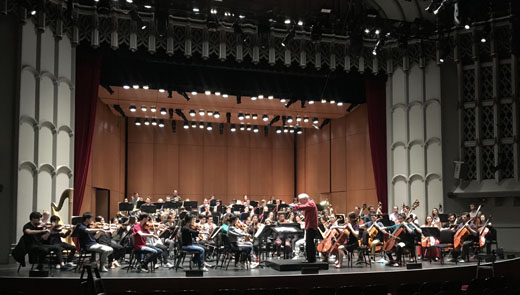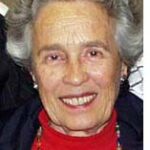
By Eileen Wingard

LOS ANGELES — The foreboding call of a lone trumpet opens the Funeral March first movement of Mahler’s Fifth Symphony, which Yoav Talmi conducted in a concert with the USC Thornton Symphony in Bovard Auditorium on March 9, and rehearsed in a master class with the UCLA Philharmonia in Schoenberg Hall the day before.
Although Talmi will be celebrating his 75 th birthday, the Israeli maestro, former conductor of the San Diego Symphony and Conductor Emeritus of the Quebec Symphony, remains a slim, agile figure on the podium, mustering vast resources of energy and passion, while leading his young forces.
The strings played with carefully calculated bow distribution, warm vibrato and accurate intonation. Most of all, their playing was beautifully expressive, with finely calibrated nuances under Talmi’s masterful direction.
The woodwinds played well also, as did the percussion and brass, especially the horn section. The solo trumpet, became more secure as the first movement progressed, producing a sweet, focused sound in his many exposed solos. Talmi conducted the challenging symphony from memory.
The Fifth Symphony, one of Mahler’s most dramatic works, was a tour de force for conductor and musicians. With the final clipped chords of the last movement, the entire audience rose for a standing ovation, roaring its praises.
He told about how he accepted the post of permanent guest conductor of the Munich Orchestra. Having lost the families of both his parents in the Holocaust, “I never knew my grandparents,” he lamented, he had no wish to conduct in Germany. However, when the Munich Orchestra, on tour, tragically lost their conductor, Talmi’s manager convinced him to step in. This was outside of Germany, in Holland, where the Talmi’s resided at that time. He soon bonded with the musicians and was invited to be their principal guest conductor. He acquiesced and at that point, learned German.
Finally, he was asked to name the concert halls in which he conducted which had the best acoustics. From Berlin’s Philharmonium to the new hall in Kansas City, from New York’s Carnegie Hall to Vienna’s Konserthaus, from Amsterdam’s Concertgebow to Munich’s Herkulussaal, this maestro has brought music to millions throughout his prestigious career.
After a half hour’s break, Talmi entered Schoenberg concert hall to work with the UCLA Philharmonia.
Stulberg was proud of his large ensemble, and, indeed, it was a much more impressive orchestra than the orchestra I had played in as a music student at UCLA in the late 40s and 50s.
The UCLA maestro relinquished his baton to Talmi to conduct the UCLA Philharmonia in a rehearsal of the first, second, third and fifth movements of Mahler’s Fifth Symphony. When Stulberg realized that, coincidentally, the UCLA Philharmonia was preparing the same repertory for its March 18 concert at the Bing Auditorium of the Los Angeles County Museum, he extended the invitation to his Tel Aviv-based colleague.
The UCLA students were well-focused during the long rehearsal. At the break, the principal flutist came up to Talmi to express her gratitude for his work.
Two of Stulberg’s students conducted the Adagietto, the famous fourth movement of the Mahler Symphony. Talmi offered constructive comments to both student conductors, but not until they played a good chunk of the piece, following his sagacious advice.
Yoav Talmi and his wife, Er’ella arrived in Los Angeles on February 24. Next day, they drove down to San Diego where they connected with several of the many friends they had made over the seven years that he was the Music Director of the San Diego Symphony Orchestra. On two occasions, following his tenure, he was invited back to guest conduct the San Diego Symphony Orchestra.
Currently, he directs the orchestral studies at the Bachmann-Mehta Music School of Tel Aviv University and continues to guest conduct throughout the world. During the coming months, he will be leading orchestras in Athens, Greece, Warsaw, Poland, Budapest, Hungary, and Montreal, Canada. He is particularly excited about this summer’s two week conducting seminar, a new program he was invited to lead at the Academy of Domaine Forget , the forty-years-old International Music Festival on the St. Lawrence River in Canada.
Yoav Talmi has been spending more time, recently, as a composer. His most recent work, a quintet for clarinet and strings won the Avidom Prize for best composition of the year, selected by the composers’ association of Israel.
*